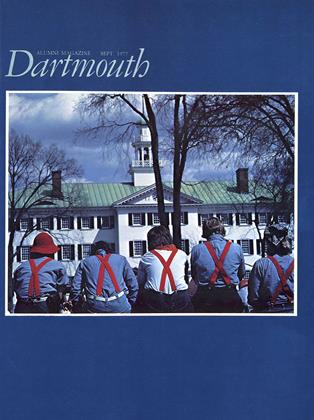When Mr. and Mrs. Edward K. Hall '92 gave Dick's House to commemorate their son, dead of polio in his sophomore year, they requested his classmates from 1927 — then still undergraduates — to present the building to the College in his name and behalf. "It would be our hope," Edward Hall wrote, "that it might help to make the members of the Class themselves feel that Dick's House is also theirs and that they will wish to help... provide a home for students of the College when they are sick, either in mind and body, and need a bit of home life and home care."
For half a century the Class of 1927 has fulfilled that commitment. Through class endowment funds, the members have helped furnish the 1927 Class Lounge; they have kept it stocked with books, periodicals, and games; they return often for class meetings and memorial services to Dick's House, over which the class flag flies during reunions; as individuals they have made personal gifts.
At rededication ceremonies held during 1927's 50th reunion, the Class handed on the baton to this year's graduates. Recalling the Halls' "earnest hope that you all will maintain your interest in the House as long as there is a single member left," Class President Kenneth H. Murray said, "This we have tried to do, and will surely continue to do." But, he added, "Now the time has come, as year by year our class inevitably diminishes in numbers, to transfer our commitment - but never our interest and concern - to another class that will carry on into the next century the tradition we have established."
Accepting the responsibility on behalf of his classmates, President Paul M. Donovan II pledged that "We, the Class of 1977, will do our best to perpetuate the traditions of warmth and friendliness that have come to be associated with Dick's House." President Kemeny expressed his thanks to 1927 for "their devoted guardianship of their class's legacy" and his pleasure that 1977 "has accepted the mantle ... until, perhaps, you decide to turn over your responsibility to the Class of 2027."
Before the Halls presented their memorial gift, Dartmouth had no infirmary. Students with minor ailments stayed in their fraternities or dormitories, those more severely ill were admitted to Mary Hitchcock Memorial Hospital, and contagious diseases were treated at the old "Pest House," near the boiler plant, by a live-in medical student who received board and room for his services. "Nothing ever planned for the College was more needed nor more certain to serve the undergraduate body at a vital time," President Hopkins responded to the Halls' announcement of their contemplated gift.
From the beginning, the attention the Hall family lavished on their memorial to their son has been as personal as the care they envisioned Dick's House providing for the students. Mr. and Mrs. Hall traveled the country, visiting hospitals and infirmaries, consulting doctors and nurses, and no detail in the planning was too small for their thoughtful consideration. There should be cheerful, well-appointed guest rooms, they decided, for the parents of critically ill students. Mrs. Hall personally selected every piece of furniture, from hospital beds to the pictures on the wall. The informal name set the homelike, non-institutional tone, and the patients' rooms are identified not by number, but by the name of a former president of the College or a renowned alumnus. Throughout her lifetime, Mrs. Hall supervised all necessary redecorating; since her death, her daughter Dorothy, wife of Lawrence Leavitt '25 of Norwich, Vermont, has seen to reupholstering and redecorating through a fund left by her mother for the purpose.
In the library, which also serves as a waiting room for out-patients, each book was given by a friend of the family or the College and is inscribed by the donor. President Calvin Coolidge, who had also lost a young son, sent his Have Faith inMassachusetts, which bears the inscription: "To my friend, Edward K. Hall, in recollection of his son and my son, who have the privilege by the grace of God, to be boys through all eternity." One of the stone steps leading up to the front door, dated 1784, came from the original Dartmouth Hall; Daniel Webster's fire bucket hangs in the vestibule; an American flag flown over the South Pole by Admiral Byrd and a fragment of another planted at the North Pole by Commander Peary hang in the patient lounge.
Conceived originally as an infirmary, with medical services provided by the adjacent Hitchcock Hospital, Dick's House in 1952 won national hospital accreditation. With rising costs and reduced need for inpatient services, thanks in large part to modern antibiotics, this summer Dick's House has reverted to infirmary status, with cases beyond its scope cared for at Mary Hitchcock.
Dick's House would "richly serve its purpose," E. K. Hall wrote in 1926 to President Hopkins and his son's classmates, if it brought comfort to the students and "if the boundless joy, the good cheer and the helpful spirit of the boy whose name it bears may for all time abide and carry on within its walls." The stewardship of that purpose passed in June from the Class of 1927 to the Class of 1977, which may in turn, as President Kemeny suggested, pass it on to the Class of 2027.
No summer doldrums here. One July weekend it was Celebration Northeast, with contradancers, folk singers, and country fiddlers; the next, the antics of Summer Carnival.
 View Full Issue
View Full Issue
More From This Issue
-
 Feature
FeatureScience and Technology Under Siege
September | October 1977 By Thomas Laaspere -
 Feature
FeatureThirty-Eight Days Alone
September | October 1977 By Ned Roesler -
 Feature
FeatureDartmouth Passages
September | October 1977 By Marshall Ledger -
 Feature
FeatureWorlds Together
September | October 1977 -
 Article
ArticleFanciers
September | October 1977 By BRAD HILLS '65 -
 Class Notes
Class Notes1927
September | October 1977 By ERWIN B. PADDOCK








